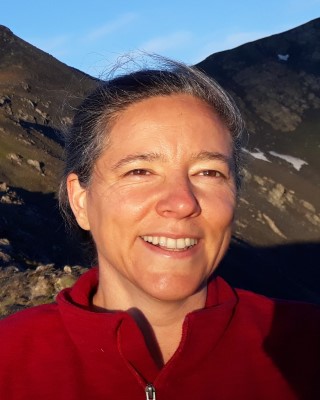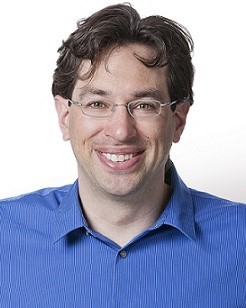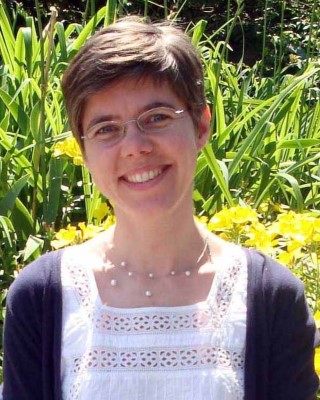 Anne Julia Rollet is a lecturer at the University of Rennes 2, affiliated to the LETG-Rennes laboratory (UMR-6554). She is a geographer who is mainly interested in fluvial geomorphology.
Anne Julia Rollet is a lecturer at the University of Rennes 2, affiliated to the LETG-Rennes laboratory (UMR-6554). She is a geographer who is mainly interested in fluvial geomorphology.
She specialises in the study of solid transport in rivers and the interactions between anthropogenic/biological activities and the morphological functioning of river systems.
Working mainly on temperate environments, she is gradually opening her research to cold environments in Nunavik and is participating in the study of the consequences of climate warming on the hydromorpho-sedimentary functioning of the Umiujaq coastal river. She is thus associated with the « HYDECO » programme.

Through twenty years of research in Iceland about the dynamic of slopes, their geomorphology and the associated risks, I gained experience that I transposed in Western Norway for instance.
The slopes of Nunavik represent a new field of study for me, demanding by their remoteness, but stimulating by the rich culture of the people who live there.
 Didier Haillot is an associate professor in the Department of Mechanical Engineering at the Ecole de technologie supérieure de Montréal and co-director of the Nunavik OHMI.
Didier Haillot is an associate professor in the Department of Mechanical Engineering at the Ecole de technologie supérieure de Montréal and co-director of the Nunavik OHMI.
He is interested in understanding thermal and thermodynamic phenomena in complex energy systems.
To do so, his research combines experimentation and modeling.The fields of application are multifunctional materials, solar thermal and photovoltaic, energy storage and management of agricultural areas in controlled environments, especially in northern territories.
Within OHMI Nunavik, he is involved in two projects :
The first one concerns the energy improvement of northern greenhouses in order to initiate a response to the problem of food insecurity in the Arctic climate (collaboration with Stéphane Gibout UPPA since 2016). Several students have worked on this topic including P. Piché (PhD in 2021 and postdoctorate in 2022). A thermal storage system adapted to northern constraints (local materials, low maintenance) has been installed in the Kuujjuaq community greenhouse. An improved replica of this system has been made in Radisson. Its coupling with a solar field is under study (master's degree of T. Maheux in progress, direction Didier Haillot and Stéphane Gibout).

She studies landscapes and modes of naturalness according to cultures through the use of photography or video, 'portraits' that trigger narratives.
Since 2008, she has been travelling through the territory of Nunavik, where she meets communities (Inuit, Cree) with whom she develops projects to update and transmit their own vision and practice of landscapes beyond the Western myth of the Great White Arctic.
These representations can collide, in the preservation projects of the National Parks (Tursujuq) as well as in the development projects (urbanization). From Wilderness to indigenous holistic naturalities, Fabienne Joliet coordinates the Nuna programme ("our land" in Inuktitut). Together with Laine Chanteloup and Thora Herrmann, they have been organising participatory video workshops on the theme of 'nuna' in Nunavik since 2015 with teenagers, the leaders of tomorrow.
These short films constitute the research data of the programme as well as a tool of visual sovereignty for indigenous communities undertaking the path of self-determination. Since the beginning of the Nuna program, 5 Nunavik communities have participated and produced a 10-minute short film: Whapmagoostui, Kuujjuaarapik, Umiujaq, Ivujivik, Kangiqsujuaq.
 Interested in geothermal energy, Professor Jasmin Raymond is conducting research work on low to medium temperature resources, including heat pump systems.
Interested in geothermal energy, Professor Jasmin Raymond is conducting research work on low to medium temperature resources, including heat pump systems.
The main objective of his projects, done in collaboration with geothermal designers, operators and manufacturers, is to improve the efficiency and profitability of systems by providing scientific and technological innovations. Field testing and numerical modeling are the main activities he carries out.
Mr Raymond is a hydrogeologist and he teaches geothermal energy basics at Institut national de la recherche scientifique in Quebec City. He obtained his Ph.D. at Laval University and a B.Sc. at McGill University.
During his young career, he received numerous prices such as a Banting Scholarship for his postdoctoral research. He currently holds a research chair from l’Institut nordique du Québec to investigate the geothermal potential of northern communities and mines in addition to be the coleader of an international research group on geothermal energy supported by UNESCO.

She has been a lecturer at the Institut Universitaire de Technologie - Social Careers department of the University of Limoges and a member of the CNRS Geolab UMR 6042 laboratory since September 2016.
She was awarded a DRIIHM labex postdoctoral fellowship in 2014-2015.
Her scientific work focuses on nature sports, including hunting, the management of natural areas, human-animal interrelations and indigenous territorialities (Inuit and Cree).
Her doctoral thesis, co-tutored by the Université de Savoie and the Université de Montréal, focused on wildlife-related recreational and tourist activities (observation and hunting) in France (Alps) and Canada (Quebec and Nunavut).
A graduate of the Institut d'Etudes Politiques in Rennes and with a Masters in Geography from the University of Grenoble, Laine Chanteloup did her doctorate under a joint supervision of the University of Savoie and the University of Montreal.
Her thesis focused on wildlife-related recreational and tourist activities (observation and hunting) in France (Alps) and Canada (Quebec and Nunavut).
She has continued her research into the management of wildlife and protected areas in mountain regions within the Zone Atelier Alpes (Massif des Bauges) and in the Canadian Arctic with the Nunavik OHMi (DRIIHM labex). Her scientific expertise covers nature sports, including hunting, the management of natural areas, human-animal interrelations and indigenous territorialities. Her research areas are the French Alps and the Canadian Arctic (Nunavut and Nunavik). She is currently an associate member of the EDYTEM laboratory (Environment and Dynamics of Mountain Territories).
Laine has been awarded a one-year postdoctoral fellowship by the DRIIHM labex. For more informations : Doctorat
 Laurent Godet is a CNRS senior scientist and works in conservation biology.
Laurent Godet is a CNRS senior scientist and works in conservation biology.
He is particularly interested in the influence of anthropogenic pressures on changes in the distribution and activity patterns of birds and mammals.
 Thora Herrmann is scientific project leader at the Institute of Advanced Sustainability Studies (IASS), Potsdam (Germany).
Thora Herrmann is scientific project leader at the Institute of Advanced Sustainability Studies (IASS), Potsdam (Germany).
She received her Doctorate in geography from the University of Oxford (United Kingdom). She holds a Diplôme d’Études Approfondies in biodiversity conservation and sustainable development from the Université de Paris-Sorbonne (France).
As cultural geographer, Thora is working since 1999 with Mapuche in Chile, since 2006 with First Nations in Québec, and with Sámi in Northern Europe on impacts of environmental change, such as climate change and extractive industries (mining, forestry), and place-people relationships as well as biocultural diversity conservation, according to two complementary axes:
1) the influence of changing environment on societies at sociocultural levels;
2) the forms of values, knowledge and use practices of the environment by societies.
She uses filmmaking as a tool for Indigenous research that addresses issues of concern for indigenous communities through the eyes of their youth.
 Najat Bhiry is Deputy Director of OHIM NUNAVIK.
Najat Bhiry is Deputy Director of OHIM NUNAVIK.
She was director of the CEN, Centre d'Etude Nordique. She is a full professor in the geography department at Laval University.
Her areas of expertise are: plant palaeoecology; Quaternary geology (stratigraphy, sedimentology, micromorphology); northern geoarchaeology. Najat is co-coordinator of the 'KINNGAQ' project, which means 'mountain'.
 Paul Piché studied Physics and Chemistry before obtaining a Master's degree in Physics of Energy and Energy Transition (PEnTE) at Paul Sabatier University in Toulouse.
Paul Piché studied Physics and Chemistry before obtaining a Master's degree in Physics of Energy and Energy Transition (PEnTE) at Paul Sabatier University in Toulouse.
He completed a thesis at the Laboratoire de Thermique Énergétique et Procédés (LaTEP) in Pau, under the supervision of Jean-Pierre Bédécarrats, Stéphane Gibout and Didier Haillot.
He is now a post-doctoral fellow at the Ecole Technologie Supérieure de Montréal. He is working on the SEQINEQ 'Energy' project and his subject is the energy optimisation of greenhouses in a circumpolar environment in order to increase the plant production period and reduce dependence on fossil fuels.
 Stéphane Gibout is Associate Professor at the Laboratoire de Thermique, Énergétique et Procédés (LaTEP, Université de Pau et des Pays de l'Adour, France) since 2002.
Stéphane Gibout is Associate Professor at the Laboratoire de Thermique, Énergétique et Procédés (LaTEP, Université de Pau et des Pays de l'Adour, France) since 2002.
He is specialized in modeling, simulation and optimization of energy systems, especially in the field of self-sufficiency and renewable energies.
Since 2018, these activities have been refocused on the field of greenhouses and photovoltaic energy.
He is working on a floating photovoltaic power plant demonstrator designed for irrigation lakes, in partnership with the Chamber of Agriculture of 64 and the Groupement des Irrigants du 64.
He is also co-leader of SIQINIQ projects (OHMi Nunavik / LabEx DRIIHM) which focuses on autonomous greenhouse farming in the North.
 Véronique Coxam is a research director at INRAE.
Véronique Coxam is a research director at INRAE.
She is in charge of the Skeletal Nutrition and Metabolism Team within the Human Nutrition Unit. (Joint INRA/University of Auvergne Research Unit, UMR 1019).
She is developing translational research into the nutritional prevention of chronic diseases (particularly osteoarticular pathologies), targeting specific nutrients as well as the holistic component of the diet.
She is the author/co-author of over 120 Pubmed-indexed publications, around twenty books/book chapters and several patents.
She is involved in the NIQILIRINIQ project, also entitled "Current eating habits, food security, nutritional health, circumpolar agriculture, northern greenhouses, local food, sustainable community development".
In this project, she is interested in improving the quality of food for the population of Kuujuaq and Kangiqsujuaq, through a greenhouse project.
